Property Law: An Analysis of Fixtures, Chattels, and VCAT Functions
VerifiedAdded on 2020/07/22
|10
|2848
|32
Report
AI Summary
This property law report examines the concepts of fixtures and chattels within the context of a property purchase scenario. It analyzes the rights of a buyer, Michael, and the implications of removing certain amenities. The report clarifies the legal definitions of fixtures (items permanently attached to land) and chattels (personal property), and their relevance in property transactions. It further explores the role of the Victorian Civil and Administrative Tribunal (VCAT) in resolving property disputes, including its function in protecting the rights of property owners and resolving issues related to fixture removal. The report references relevant case law, such as National Dairies WA Ltd. v Commissioner of State Revenue and Macrocom v City West Centre Pty. Ltd., to illustrate legal principles. The analysis concludes with advice for Michael on how to address the removal of amenities, such as a television antenna, and the solar battery unit and how to file a complaint with VCAT to protect his interests.
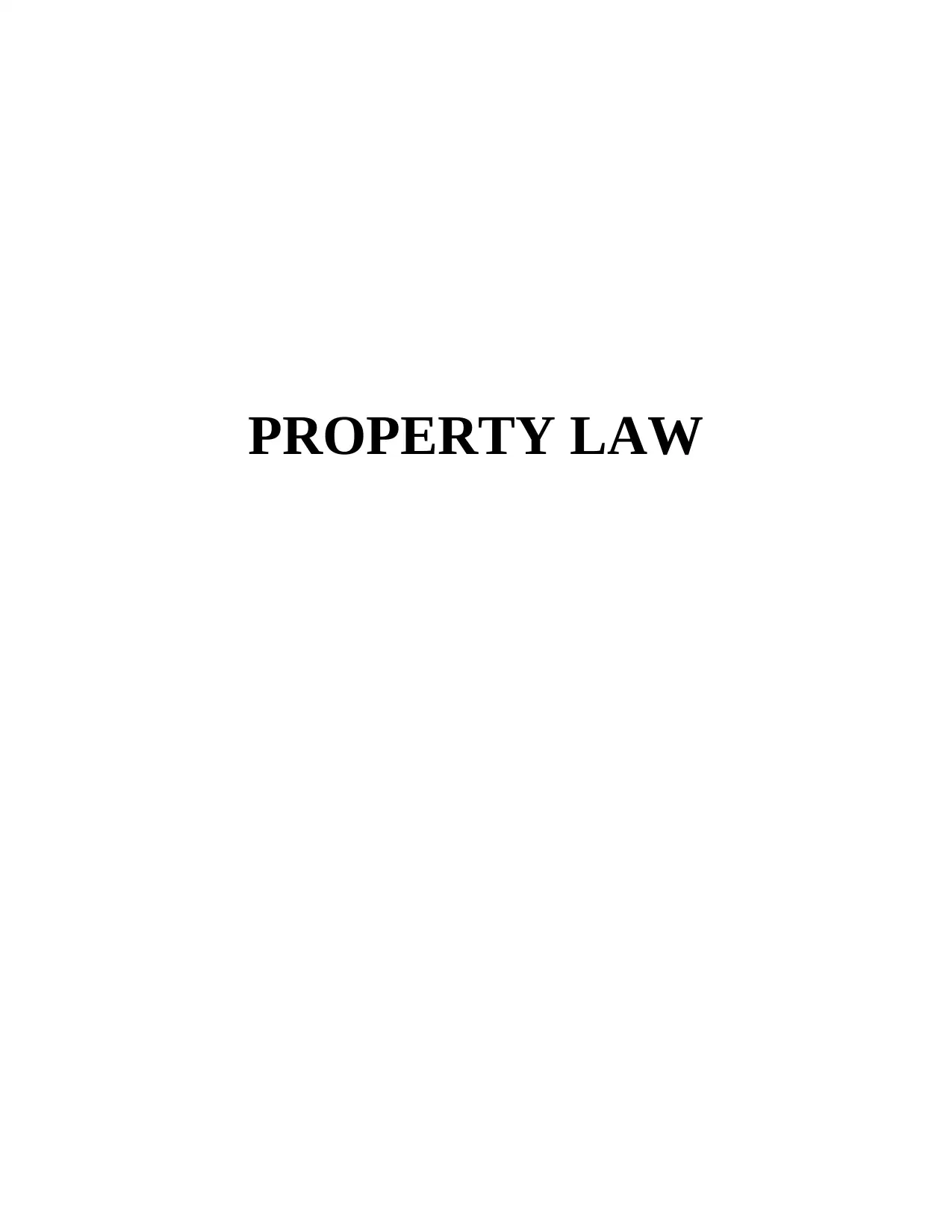
PROPERTY LAW
Paraphrase This Document
Need a fresh take? Get an instant paraphrase of this document with our AI Paraphraser
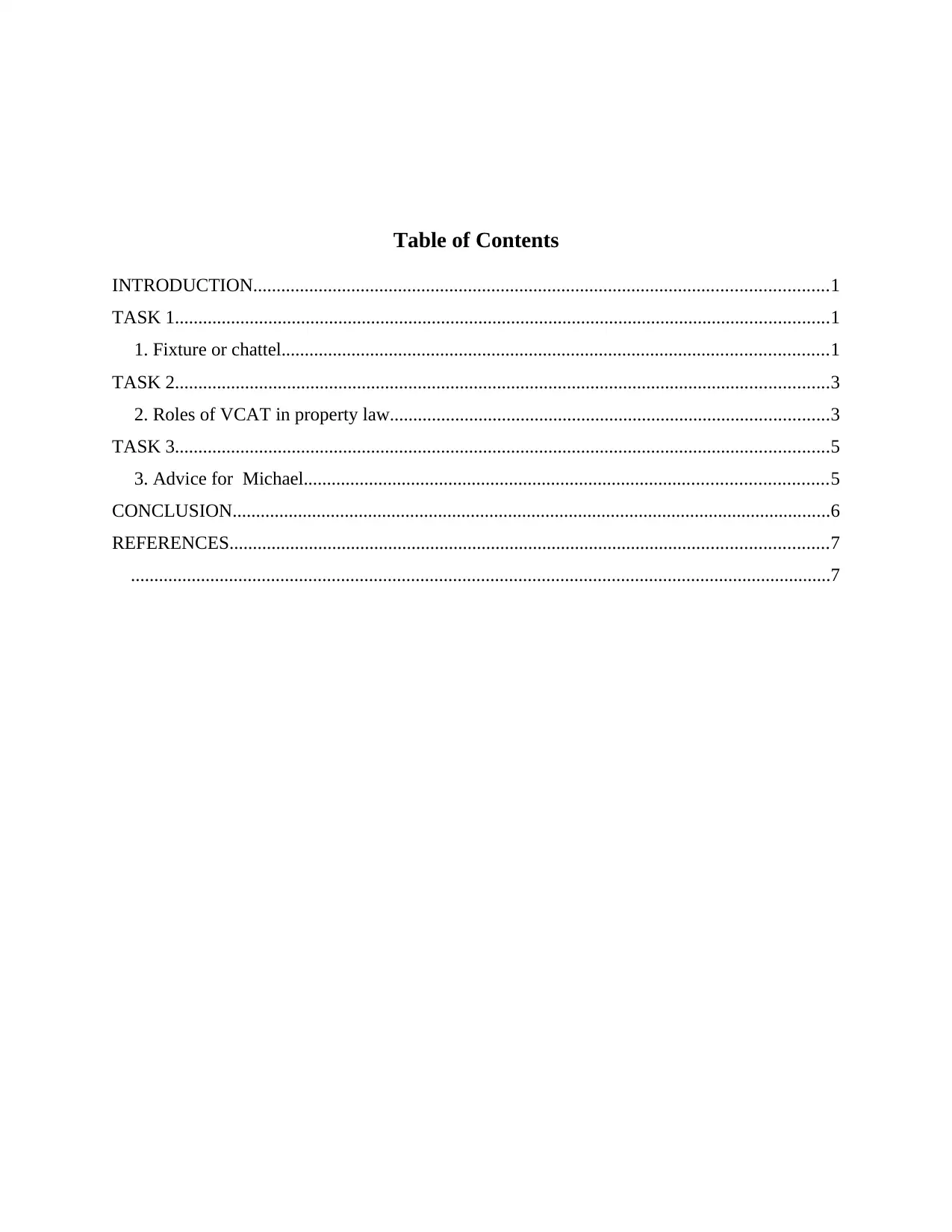
Table of Contents
INTRODUCTION...........................................................................................................................1
TASK 1............................................................................................................................................1
1. Fixture or chattel.....................................................................................................................1
TASK 2............................................................................................................................................3
2. Roles of VCAT in property law..............................................................................................3
TASK 3............................................................................................................................................5
3. Advice for Michael................................................................................................................5
CONCLUSION................................................................................................................................6
REFERENCES................................................................................................................................7
......................................................................................................................................................7
INTRODUCTION...........................................................................................................................1
TASK 1............................................................................................................................................1
1. Fixture or chattel.....................................................................................................................1
TASK 2............................................................................................................................................3
2. Roles of VCAT in property law..............................................................................................3
TASK 3............................................................................................................................................5
3. Advice for Michael................................................................................................................5
CONCLUSION................................................................................................................................6
REFERENCES................................................................................................................................7
......................................................................................................................................................7

⊘ This is a preview!⊘
Do you want full access?
Subscribe today to unlock all pages.

Trusted by 1+ million students worldwide
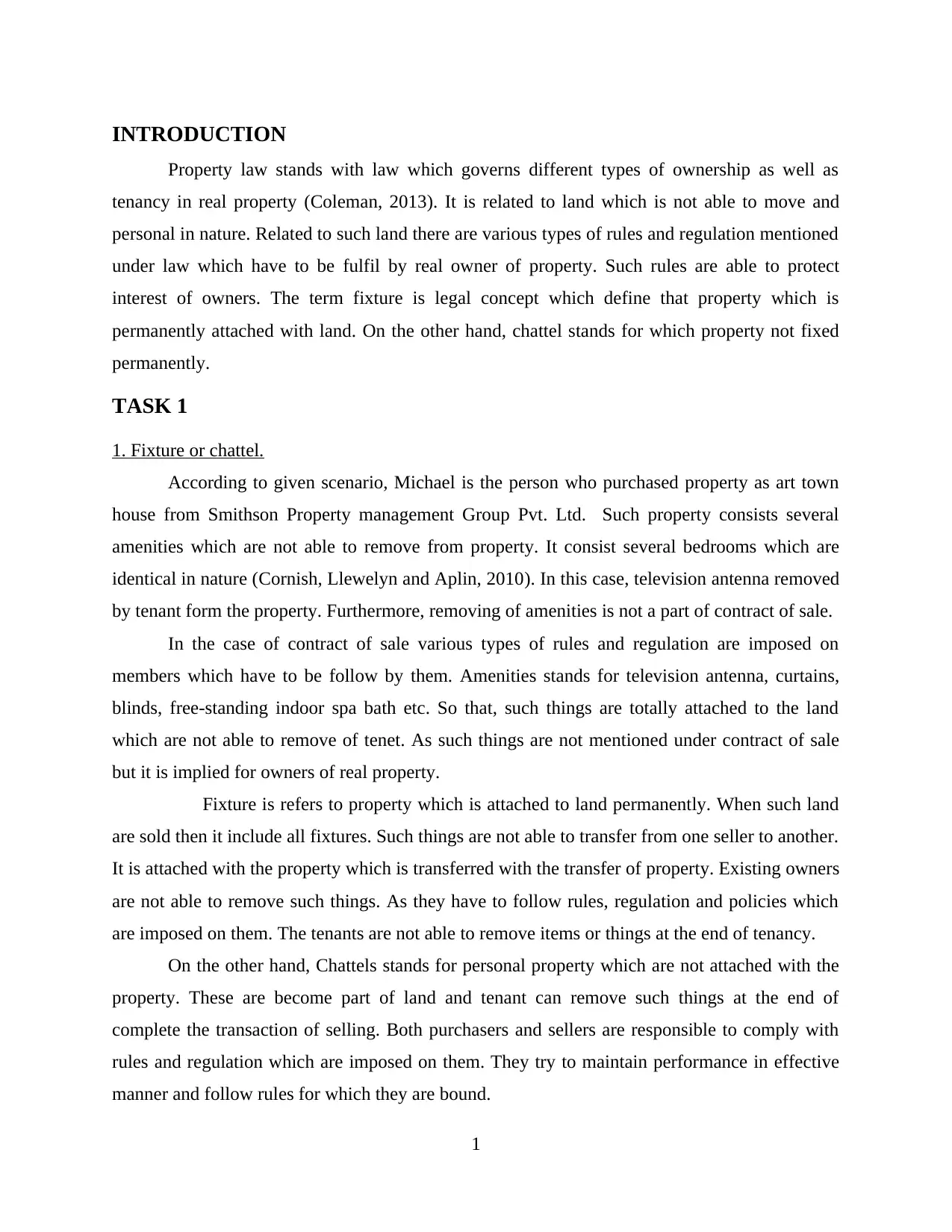
INTRODUCTION
Property law stands with law which governs different types of ownership as well as
tenancy in real property (Coleman, 2013). It is related to land which is not able to move and
personal in nature. Related to such land there are various types of rules and regulation mentioned
under law which have to be fulfil by real owner of property. Such rules are able to protect
interest of owners. The term fixture is legal concept which define that property which is
permanently attached with land. On the other hand, chattel stands for which property not fixed
permanently.
TASK 1
1. Fixture or chattel.
According to given scenario, Michael is the person who purchased property as art town
house from Smithson Property management Group Pvt. Ltd. Such property consists several
amenities which are not able to remove from property. It consist several bedrooms which are
identical in nature (Cornish, Llewelyn and Aplin, 2010). In this case, television antenna removed
by tenant form the property. Furthermore, removing of amenities is not a part of contract of sale.
In the case of contract of sale various types of rules and regulation are imposed on
members which have to be follow by them. Amenities stands for television antenna, curtains,
blinds, free-standing indoor spa bath etc. So that, such things are totally attached to the land
which are not able to remove of tenet. As such things are not mentioned under contract of sale
but it is implied for owners of real property.
Fixture is refers to property which is attached to land permanently. When such land
are sold then it include all fixtures. Such things are not able to transfer from one seller to another.
It is attached with the property which is transferred with the transfer of property. Existing owners
are not able to remove such things. As they have to follow rules, regulation and policies which
are imposed on them. The tenants are not able to remove items or things at the end of tenancy.
On the other hand, Chattels stands for personal property which are not attached with the
property. These are become part of land and tenant can remove such things at the end of
complete the transaction of selling. Both purchasers and sellers are responsible to comply with
rules and regulation which are imposed on them. They try to maintain performance in effective
manner and follow rules for which they are bound.
1
Property law stands with law which governs different types of ownership as well as
tenancy in real property (Coleman, 2013). It is related to land which is not able to move and
personal in nature. Related to such land there are various types of rules and regulation mentioned
under law which have to be fulfil by real owner of property. Such rules are able to protect
interest of owners. The term fixture is legal concept which define that property which is
permanently attached with land. On the other hand, chattel stands for which property not fixed
permanently.
TASK 1
1. Fixture or chattel.
According to given scenario, Michael is the person who purchased property as art town
house from Smithson Property management Group Pvt. Ltd. Such property consists several
amenities which are not able to remove from property. It consist several bedrooms which are
identical in nature (Cornish, Llewelyn and Aplin, 2010). In this case, television antenna removed
by tenant form the property. Furthermore, removing of amenities is not a part of contract of sale.
In the case of contract of sale various types of rules and regulation are imposed on
members which have to be follow by them. Amenities stands for television antenna, curtains,
blinds, free-standing indoor spa bath etc. So that, such things are totally attached to the land
which are not able to remove of tenet. As such things are not mentioned under contract of sale
but it is implied for owners of real property.
Fixture is refers to property which is attached to land permanently. When such land
are sold then it include all fixtures. Such things are not able to transfer from one seller to another.
It is attached with the property which is transferred with the transfer of property. Existing owners
are not able to remove such things. As they have to follow rules, regulation and policies which
are imposed on them. The tenants are not able to remove items or things at the end of tenancy.
On the other hand, Chattels stands for personal property which are not attached with the
property. These are become part of land and tenant can remove such things at the end of
complete the transaction of selling. Both purchasers and sellers are responsible to comply with
rules and regulation which are imposed on them. They try to maintain performance in effective
manner and follow rules for which they are bound.
1
Paraphrase This Document
Need a fresh take? Get an instant paraphrase of this document with our AI Paraphraser
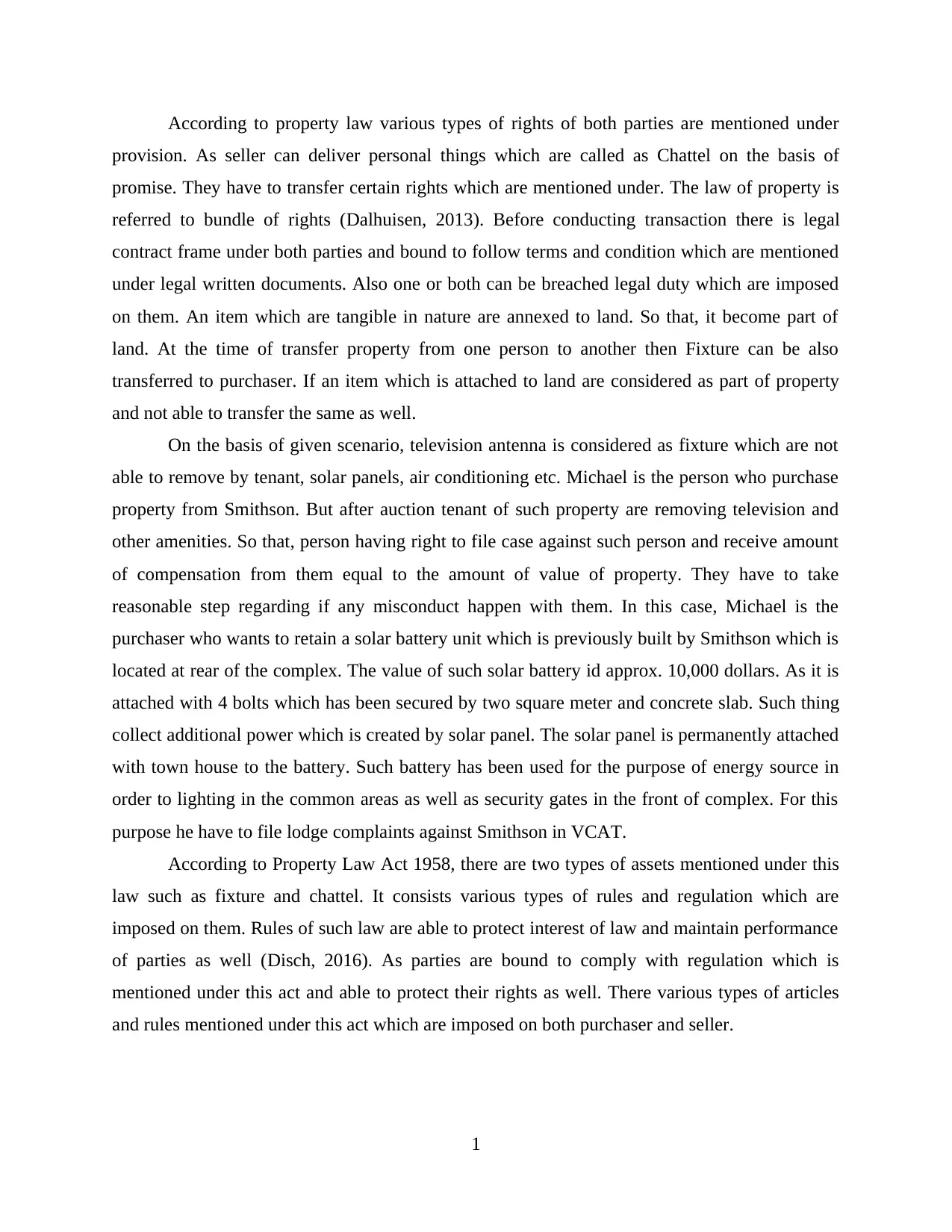
According to property law various types of rights of both parties are mentioned under
provision. As seller can deliver personal things which are called as Chattel on the basis of
promise. They have to transfer certain rights which are mentioned under. The law of property is
referred to bundle of rights (Dalhuisen, 2013). Before conducting transaction there is legal
contract frame under both parties and bound to follow terms and condition which are mentioned
under legal written documents. Also one or both can be breached legal duty which are imposed
on them. An item which are tangible in nature are annexed to land. So that, it become part of
land. At the time of transfer property from one person to another then Fixture can be also
transferred to purchaser. If an item which is attached to land are considered as part of property
and not able to transfer the same as well.
On the basis of given scenario, television antenna is considered as fixture which are not
able to remove by tenant, solar panels, air conditioning etc. Michael is the person who purchase
property from Smithson. But after auction tenant of such property are removing television and
other amenities. So that, person having right to file case against such person and receive amount
of compensation from them equal to the amount of value of property. They have to take
reasonable step regarding if any misconduct happen with them. In this case, Michael is the
purchaser who wants to retain a solar battery unit which is previously built by Smithson which is
located at rear of the complex. The value of such solar battery id approx. 10,000 dollars. As it is
attached with 4 bolts which has been secured by two square meter and concrete slab. Such thing
collect additional power which is created by solar panel. The solar panel is permanently attached
with town house to the battery. Such battery has been used for the purpose of energy source in
order to lighting in the common areas as well as security gates in the front of complex. For this
purpose he have to file lodge complaints against Smithson in VCAT.
According to Property Law Act 1958, there are two types of assets mentioned under this
law such as fixture and chattel. It consists various types of rules and regulation which are
imposed on them. Rules of such law are able to protect interest of law and maintain performance
of parties as well (Disch, 2016). As parties are bound to comply with regulation which is
mentioned under this act and able to protect their rights as well. There various types of articles
and rules mentioned under this act which are imposed on both purchaser and seller.
1
provision. As seller can deliver personal things which are called as Chattel on the basis of
promise. They have to transfer certain rights which are mentioned under. The law of property is
referred to bundle of rights (Dalhuisen, 2013). Before conducting transaction there is legal
contract frame under both parties and bound to follow terms and condition which are mentioned
under legal written documents. Also one or both can be breached legal duty which are imposed
on them. An item which are tangible in nature are annexed to land. So that, it become part of
land. At the time of transfer property from one person to another then Fixture can be also
transferred to purchaser. If an item which is attached to land are considered as part of property
and not able to transfer the same as well.
On the basis of given scenario, television antenna is considered as fixture which are not
able to remove by tenant, solar panels, air conditioning etc. Michael is the person who purchase
property from Smithson. But after auction tenant of such property are removing television and
other amenities. So that, person having right to file case against such person and receive amount
of compensation from them equal to the amount of value of property. They have to take
reasonable step regarding if any misconduct happen with them. In this case, Michael is the
purchaser who wants to retain a solar battery unit which is previously built by Smithson which is
located at rear of the complex. The value of such solar battery id approx. 10,000 dollars. As it is
attached with 4 bolts which has been secured by two square meter and concrete slab. Such thing
collect additional power which is created by solar panel. The solar panel is permanently attached
with town house to the battery. Such battery has been used for the purpose of energy source in
order to lighting in the common areas as well as security gates in the front of complex. For this
purpose he have to file lodge complaints against Smithson in VCAT.
According to Property Law Act 1958, there are two types of assets mentioned under this
law such as fixture and chattel. It consists various types of rules and regulation which are
imposed on them. Rules of such law are able to protect interest of law and maintain performance
of parties as well (Disch, 2016). As parties are bound to comply with regulation which is
mentioned under this act and able to protect their rights as well. There various types of articles
and rules mentioned under this act which are imposed on both purchaser and seller.
1
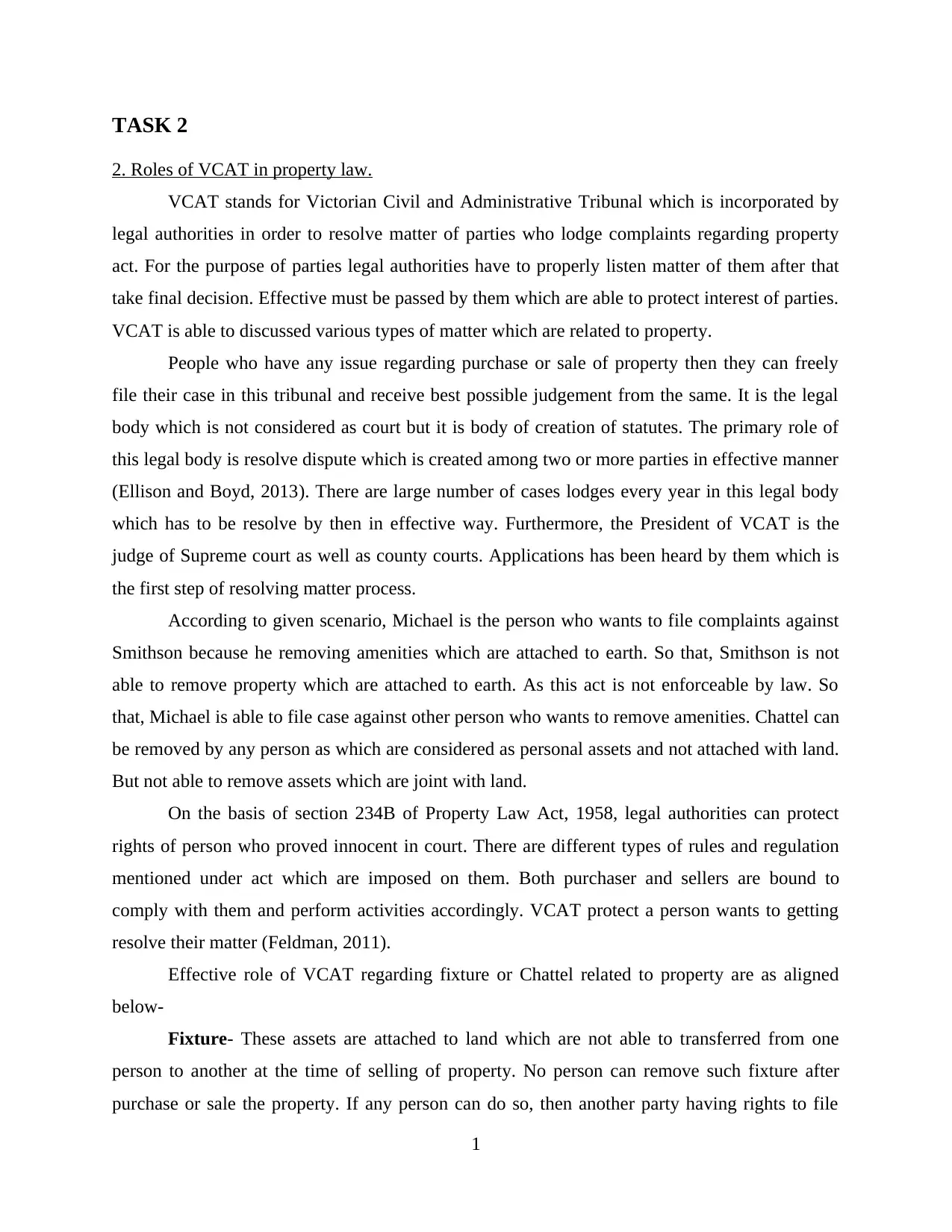
TASK 2
2. Roles of VCAT in property law.
VCAT stands for Victorian Civil and Administrative Tribunal which is incorporated by
legal authorities in order to resolve matter of parties who lodge complaints regarding property
act. For the purpose of parties legal authorities have to properly listen matter of them after that
take final decision. Effective must be passed by them which are able to protect interest of parties.
VCAT is able to discussed various types of matter which are related to property.
People who have any issue regarding purchase or sale of property then they can freely
file their case in this tribunal and receive best possible judgement from the same. It is the legal
body which is not considered as court but it is body of creation of statutes. The primary role of
this legal body is resolve dispute which is created among two or more parties in effective manner
(Ellison and Boyd, 2013). There are large number of cases lodges every year in this legal body
which has to be resolve by then in effective way. Furthermore, the President of VCAT is the
judge of Supreme court as well as county courts. Applications has been heard by them which is
the first step of resolving matter process.
According to given scenario, Michael is the person who wants to file complaints against
Smithson because he removing amenities which are attached to earth. So that, Smithson is not
able to remove property which are attached to earth. As this act is not enforceable by law. So
that, Michael is able to file case against other person who wants to remove amenities. Chattel can
be removed by any person as which are considered as personal assets and not attached with land.
But not able to remove assets which are joint with land.
On the basis of section 234B of Property Law Act, 1958, legal authorities can protect
rights of person who proved innocent in court. There are different types of rules and regulation
mentioned under act which are imposed on them. Both purchaser and sellers are bound to
comply with them and perform activities accordingly. VCAT protect a person wants to getting
resolve their matter (Feldman, 2011).
Effective role of VCAT regarding fixture or Chattel related to property are as aligned
below-
Fixture- These assets are attached to land which are not able to transferred from one
person to another at the time of selling of property. No person can remove such fixture after
purchase or sale the property. If any person can do so, then another party having rights to file
1
2. Roles of VCAT in property law.
VCAT stands for Victorian Civil and Administrative Tribunal which is incorporated by
legal authorities in order to resolve matter of parties who lodge complaints regarding property
act. For the purpose of parties legal authorities have to properly listen matter of them after that
take final decision. Effective must be passed by them which are able to protect interest of parties.
VCAT is able to discussed various types of matter which are related to property.
People who have any issue regarding purchase or sale of property then they can freely
file their case in this tribunal and receive best possible judgement from the same. It is the legal
body which is not considered as court but it is body of creation of statutes. The primary role of
this legal body is resolve dispute which is created among two or more parties in effective manner
(Ellison and Boyd, 2013). There are large number of cases lodges every year in this legal body
which has to be resolve by then in effective way. Furthermore, the President of VCAT is the
judge of Supreme court as well as county courts. Applications has been heard by them which is
the first step of resolving matter process.
According to given scenario, Michael is the person who wants to file complaints against
Smithson because he removing amenities which are attached to earth. So that, Smithson is not
able to remove property which are attached to earth. As this act is not enforceable by law. So
that, Michael is able to file case against other person who wants to remove amenities. Chattel can
be removed by any person as which are considered as personal assets and not attached with land.
But not able to remove assets which are joint with land.
On the basis of section 234B of Property Law Act, 1958, legal authorities can protect
rights of person who proved innocent in court. There are different types of rules and regulation
mentioned under act which are imposed on them. Both purchaser and sellers are bound to
comply with them and perform activities accordingly. VCAT protect a person wants to getting
resolve their matter (Feldman, 2011).
Effective role of VCAT regarding fixture or Chattel related to property are as aligned
below-
Fixture- These assets are attached to land which are not able to transferred from one
person to another at the time of selling of property. No person can remove such fixture after
purchase or sale the property. If any person can do so, then another party having rights to file
1
⊘ This is a preview!⊘
Do you want full access?
Subscribe today to unlock all pages.

Trusted by 1+ million students worldwide
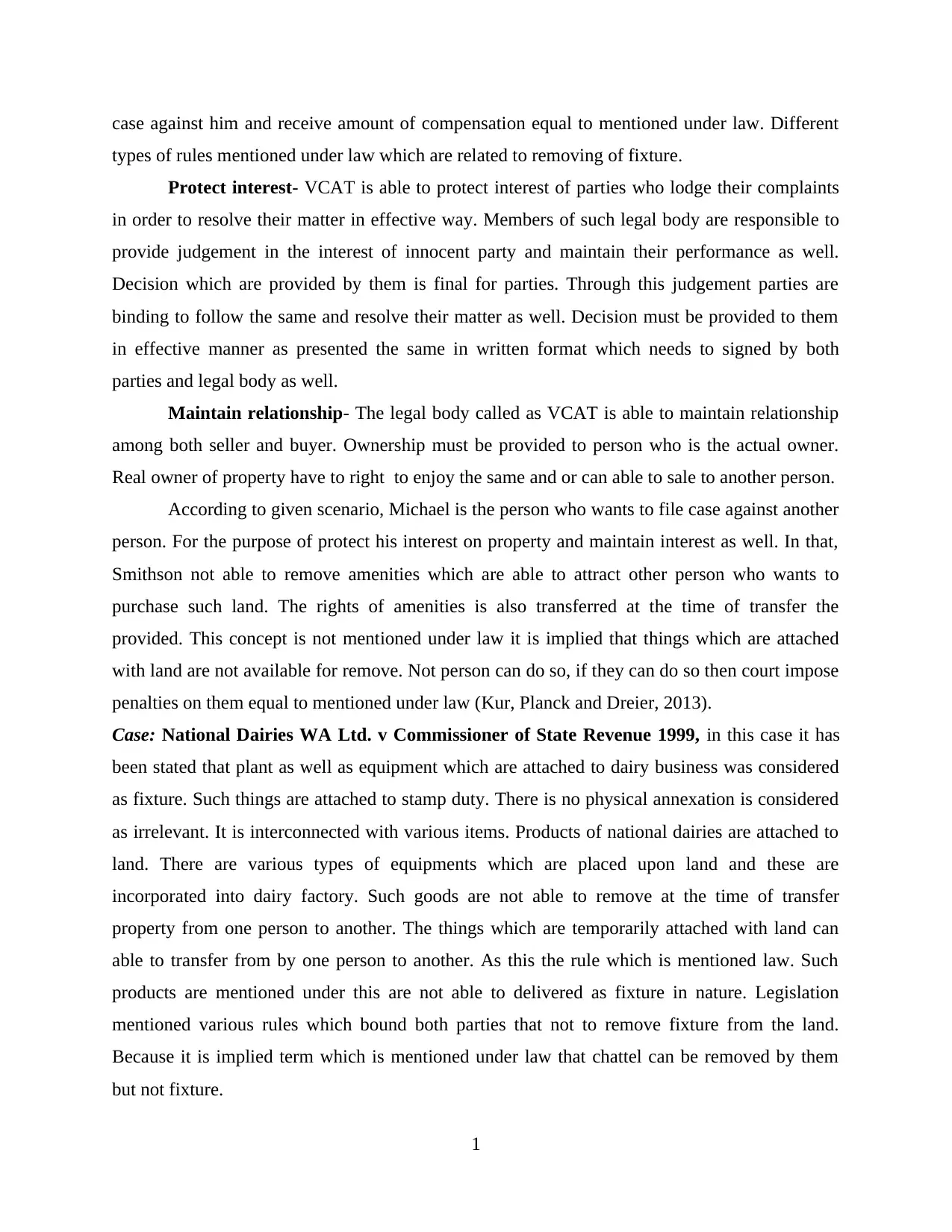
case against him and receive amount of compensation equal to mentioned under law. Different
types of rules mentioned under law which are related to removing of fixture.
Protect interest- VCAT is able to protect interest of parties who lodge their complaints
in order to resolve their matter in effective way. Members of such legal body are responsible to
provide judgement in the interest of innocent party and maintain their performance as well.
Decision which are provided by them is final for parties. Through this judgement parties are
binding to follow the same and resolve their matter as well. Decision must be provided to them
in effective manner as presented the same in written format which needs to signed by both
parties and legal body as well.
Maintain relationship- The legal body called as VCAT is able to maintain relationship
among both seller and buyer. Ownership must be provided to person who is the actual owner.
Real owner of property have to right to enjoy the same and or can able to sale to another person.
According to given scenario, Michael is the person who wants to file case against another
person. For the purpose of protect his interest on property and maintain interest as well. In that,
Smithson not able to remove amenities which are able to attract other person who wants to
purchase such land. The rights of amenities is also transferred at the time of transfer the
provided. This concept is not mentioned under law it is implied that things which are attached
with land are not available for remove. Not person can do so, if they can do so then court impose
penalties on them equal to mentioned under law (Kur, Planck and Dreier, 2013).
Case: National Dairies WA Ltd. v Commissioner of State Revenue 1999, in this case it has
been stated that plant as well as equipment which are attached to dairy business was considered
as fixture. Such things are attached to stamp duty. There is no physical annexation is considered
as irrelevant. It is interconnected with various items. Products of national dairies are attached to
land. There are various types of equipments which are placed upon land and these are
incorporated into dairy factory. Such goods are not able to remove at the time of transfer
property from one person to another. The things which are temporarily attached with land can
able to transfer from by one person to another. As this the rule which is mentioned law. Such
products are mentioned under this are not able to delivered as fixture in nature. Legislation
mentioned various rules which bound both parties that not to remove fixture from the land.
Because it is implied term which is mentioned under law that chattel can be removed by them
but not fixture.
1
types of rules mentioned under law which are related to removing of fixture.
Protect interest- VCAT is able to protect interest of parties who lodge their complaints
in order to resolve their matter in effective way. Members of such legal body are responsible to
provide judgement in the interest of innocent party and maintain their performance as well.
Decision which are provided by them is final for parties. Through this judgement parties are
binding to follow the same and resolve their matter as well. Decision must be provided to them
in effective manner as presented the same in written format which needs to signed by both
parties and legal body as well.
Maintain relationship- The legal body called as VCAT is able to maintain relationship
among both seller and buyer. Ownership must be provided to person who is the actual owner.
Real owner of property have to right to enjoy the same and or can able to sale to another person.
According to given scenario, Michael is the person who wants to file case against another
person. For the purpose of protect his interest on property and maintain interest as well. In that,
Smithson not able to remove amenities which are able to attract other person who wants to
purchase such land. The rights of amenities is also transferred at the time of transfer the
provided. This concept is not mentioned under law it is implied that things which are attached
with land are not available for remove. Not person can do so, if they can do so then court impose
penalties on them equal to mentioned under law (Kur, Planck and Dreier, 2013).
Case: National Dairies WA Ltd. v Commissioner of State Revenue 1999, in this case it has
been stated that plant as well as equipment which are attached to dairy business was considered
as fixture. Such things are attached to stamp duty. There is no physical annexation is considered
as irrelevant. It is interconnected with various items. Products of national dairies are attached to
land. There are various types of equipments which are placed upon land and these are
incorporated into dairy factory. Such goods are not able to remove at the time of transfer
property from one person to another. The things which are temporarily attached with land can
able to transfer from by one person to another. As this the rule which is mentioned law. Such
products are mentioned under this are not able to delivered as fixture in nature. Legislation
mentioned various rules which bound both parties that not to remove fixture from the land.
Because it is implied term which is mentioned under law that chattel can be removed by them
but not fixture.
1
Paraphrase This Document
Need a fresh take? Get an instant paraphrase of this document with our AI Paraphraser
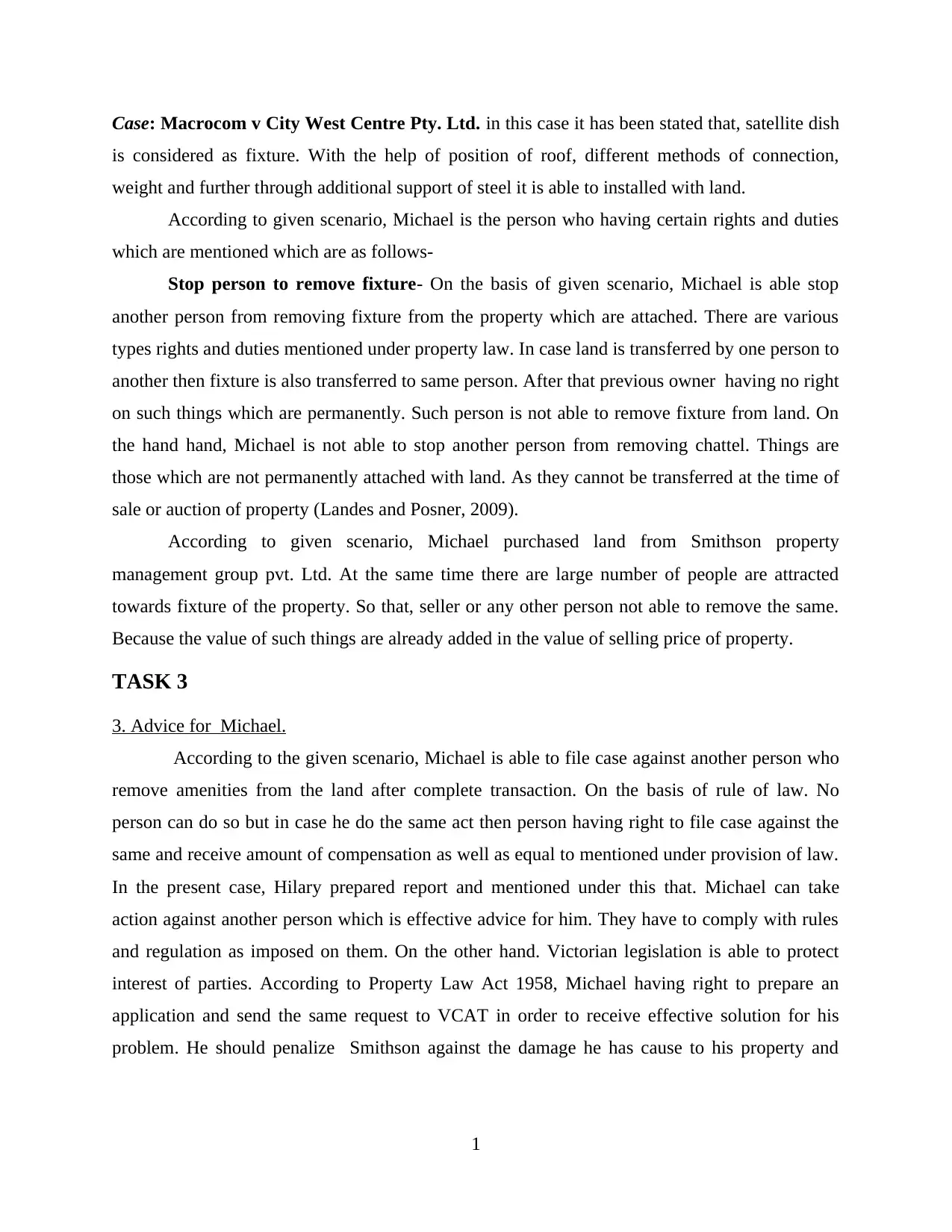
Case: Macrocom v City West Centre Pty. Ltd. in this case it has been stated that, satellite dish
is considered as fixture. With the help of position of roof, different methods of connection,
weight and further through additional support of steel it is able to installed with land.
According to given scenario, Michael is the person who having certain rights and duties
which are mentioned which are as follows-
Stop person to remove fixture- On the basis of given scenario, Michael is able stop
another person from removing fixture from the property which are attached. There are various
types rights and duties mentioned under property law. In case land is transferred by one person to
another then fixture is also transferred to same person. After that previous owner having no right
on such things which are permanently. Such person is not able to remove fixture from land. On
the hand hand, Michael is not able to stop another person from removing chattel. Things are
those which are not permanently attached with land. As they cannot be transferred at the time of
sale or auction of property (Landes and Posner, 2009).
According to given scenario, Michael purchased land from Smithson property
management group pvt. Ltd. At the same time there are large number of people are attracted
towards fixture of the property. So that, seller or any other person not able to remove the same.
Because the value of such things are already added in the value of selling price of property.
TASK 3
3. Advice for Michael.
According to the given scenario, Michael is able to file case against another person who
remove amenities from the land after complete transaction. On the basis of rule of law. No
person can do so but in case he do the same act then person having right to file case against the
same and receive amount of compensation as well as equal to mentioned under provision of law.
In the present case, Hilary prepared report and mentioned under this that. Michael can take
action against another person which is effective advice for him. They have to comply with rules
and regulation as imposed on them. On the other hand. Victorian legislation is able to protect
interest of parties. According to Property Law Act 1958, Michael having right to prepare an
application and send the same request to VCAT in order to receive effective solution for his
problem. He should penalize Smithson against the damage he has cause to his property and
1
is considered as fixture. With the help of position of roof, different methods of connection,
weight and further through additional support of steel it is able to installed with land.
According to given scenario, Michael is the person who having certain rights and duties
which are mentioned which are as follows-
Stop person to remove fixture- On the basis of given scenario, Michael is able stop
another person from removing fixture from the property which are attached. There are various
types rights and duties mentioned under property law. In case land is transferred by one person to
another then fixture is also transferred to same person. After that previous owner having no right
on such things which are permanently. Such person is not able to remove fixture from land. On
the hand hand, Michael is not able to stop another person from removing chattel. Things are
those which are not permanently attached with land. As they cannot be transferred at the time of
sale or auction of property (Landes and Posner, 2009).
According to given scenario, Michael purchased land from Smithson property
management group pvt. Ltd. At the same time there are large number of people are attracted
towards fixture of the property. So that, seller or any other person not able to remove the same.
Because the value of such things are already added in the value of selling price of property.
TASK 3
3. Advice for Michael.
According to the given scenario, Michael is able to file case against another person who
remove amenities from the land after complete transaction. On the basis of rule of law. No
person can do so but in case he do the same act then person having right to file case against the
same and receive amount of compensation as well as equal to mentioned under provision of law.
In the present case, Hilary prepared report and mentioned under this that. Michael can take
action against another person which is effective advice for him. They have to comply with rules
and regulation as imposed on them. On the other hand. Victorian legislation is able to protect
interest of parties. According to Property Law Act 1958, Michael having right to prepare an
application and send the same request to VCAT in order to receive effective solution for his
problem. He should penalize Smithson against the damage he has cause to his property and
1
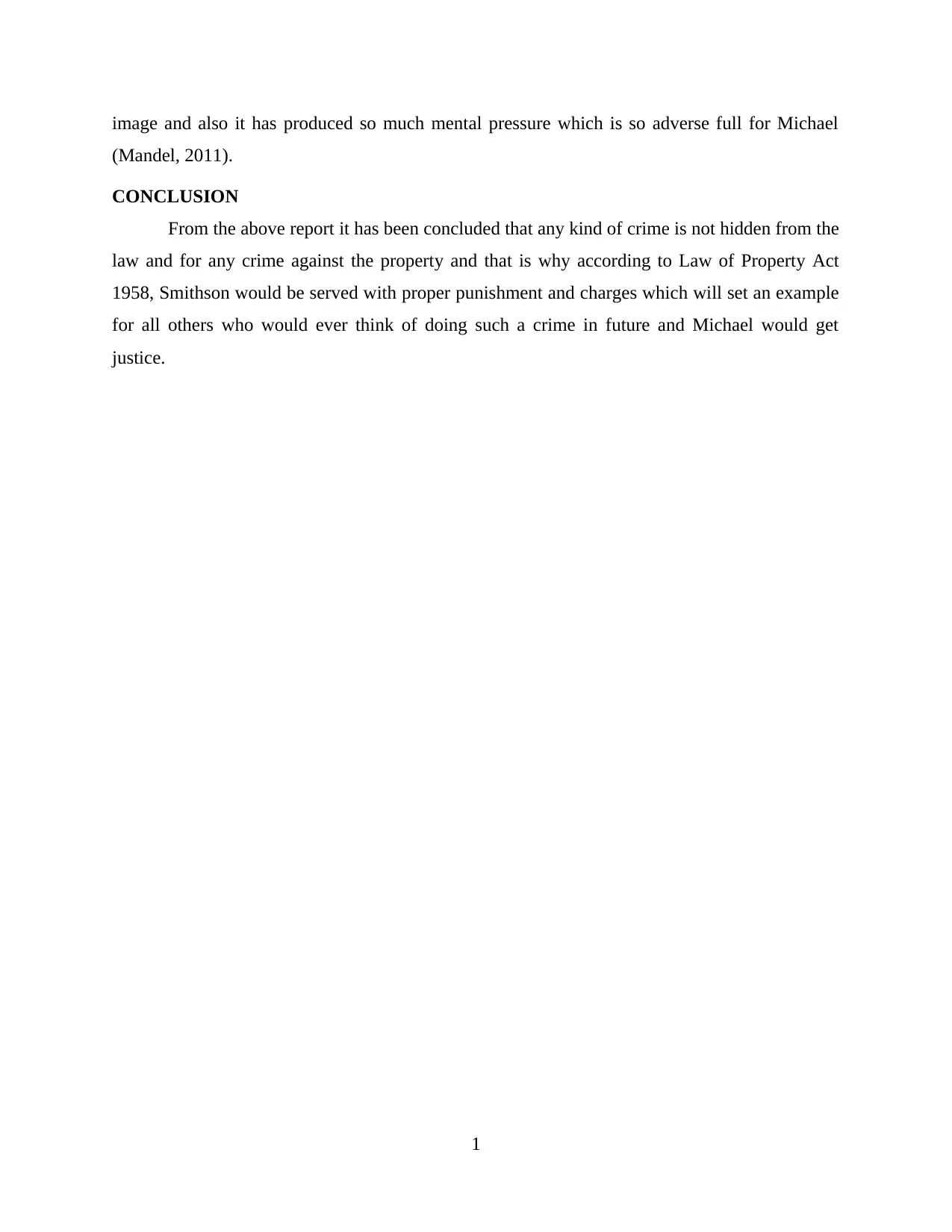
image and also it has produced so much mental pressure which is so adverse full for Michael
(Mandel, 2011).
CONCLUSION
From the above report it has been concluded that any kind of crime is not hidden from the
law and for any crime against the property and that is why according to Law of Property Act
1958, Smithson would be served with proper punishment and charges which will set an example
for all others who would ever think of doing such a crime in future and Michael would get
justice.
1
(Mandel, 2011).
CONCLUSION
From the above report it has been concluded that any kind of crime is not hidden from the
law and for any crime against the property and that is why according to Law of Property Act
1958, Smithson would be served with proper punishment and charges which will set an example
for all others who would ever think of doing such a crime in future and Michael would get
justice.
1
⊘ This is a preview!⊘
Do you want full access?
Subscribe today to unlock all pages.

Trusted by 1+ million students worldwide
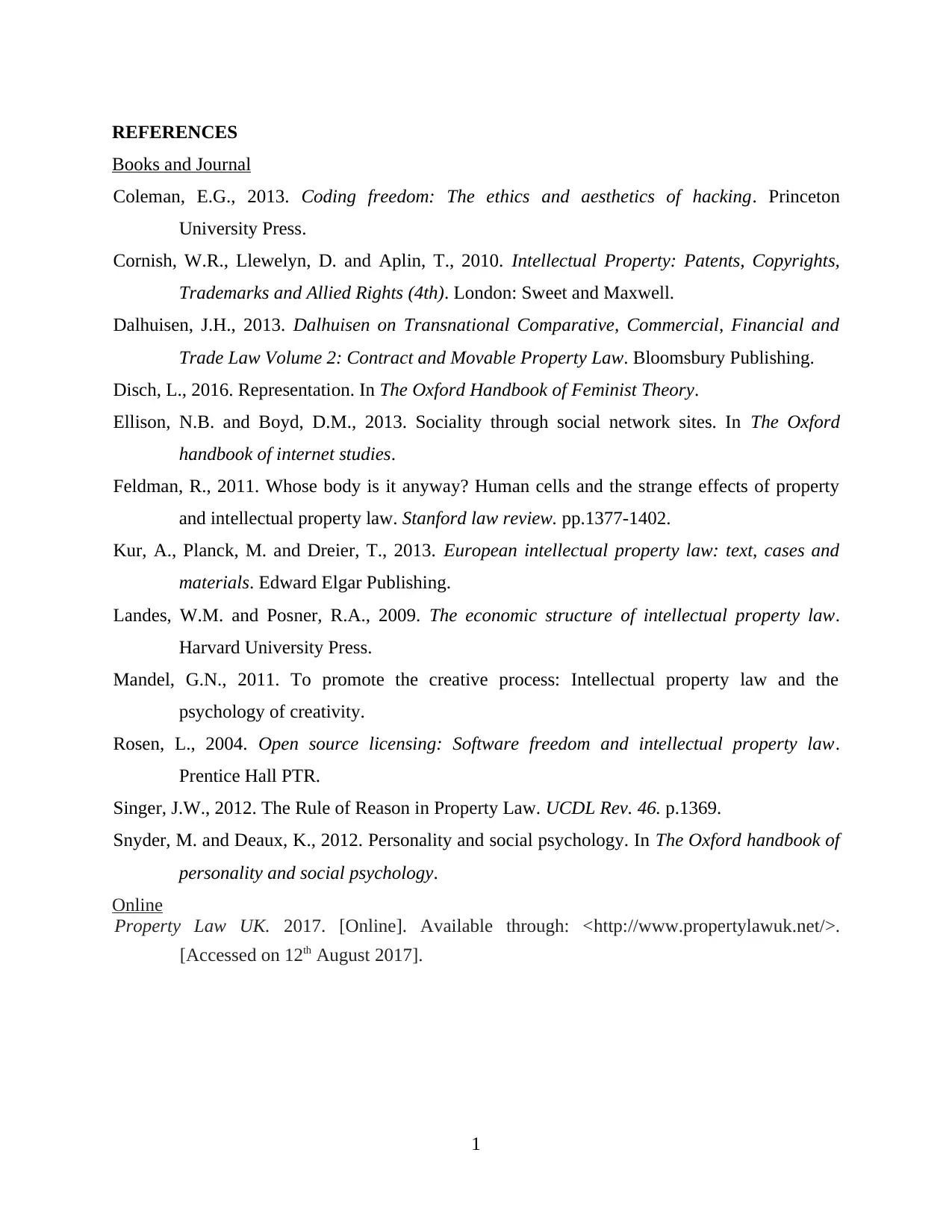
REFERENCES
Books and Journal
Coleman, E.G., 2013. Coding freedom: The ethics and aesthetics of hacking. Princeton
University Press.
Cornish, W.R., Llewelyn, D. and Aplin, T., 2010. Intellectual Property: Patents, Copyrights,
Trademarks and Allied Rights (4th). London: Sweet and Maxwell.
Dalhuisen, J.H., 2013. Dalhuisen on Transnational Comparative, Commercial, Financial and
Trade Law Volume 2: Contract and Movable Property Law. Bloomsbury Publishing.
Disch, L., 2016. Representation. In The Oxford Handbook of Feminist Theory.
Ellison, N.B. and Boyd, D.M., 2013. Sociality through social network sites. In The Oxford
handbook of internet studies.
Feldman, R., 2011. Whose body is it anyway? Human cells and the strange effects of property
and intellectual property law. Stanford law review. pp.1377-1402.
Kur, A., Planck, M. and Dreier, T., 2013. European intellectual property law: text, cases and
materials. Edward Elgar Publishing.
Landes, W.M. and Posner, R.A., 2009. The economic structure of intellectual property law.
Harvard University Press.
Mandel, G.N., 2011. To promote the creative process: Intellectual property law and the
psychology of creativity.
Rosen, L., 2004. Open source licensing: Software freedom and intellectual property law.
Prentice Hall PTR.
Singer, J.W., 2012. The Rule of Reason in Property Law. UCDL Rev. 46. p.1369.
Snyder, M. and Deaux, K., 2012. Personality and social psychology. In The Oxford handbook of
personality and social psychology.
Online
Property Law UK. 2017. [Online]. Available through: <http://www.propertylawuk.net/>.
[Accessed on 12th August 2017].
1
Books and Journal
Coleman, E.G., 2013. Coding freedom: The ethics and aesthetics of hacking. Princeton
University Press.
Cornish, W.R., Llewelyn, D. and Aplin, T., 2010. Intellectual Property: Patents, Copyrights,
Trademarks and Allied Rights (4th). London: Sweet and Maxwell.
Dalhuisen, J.H., 2013. Dalhuisen on Transnational Comparative, Commercial, Financial and
Trade Law Volume 2: Contract and Movable Property Law. Bloomsbury Publishing.
Disch, L., 2016. Representation. In The Oxford Handbook of Feminist Theory.
Ellison, N.B. and Boyd, D.M., 2013. Sociality through social network sites. In The Oxford
handbook of internet studies.
Feldman, R., 2011. Whose body is it anyway? Human cells and the strange effects of property
and intellectual property law. Stanford law review. pp.1377-1402.
Kur, A., Planck, M. and Dreier, T., 2013. European intellectual property law: text, cases and
materials. Edward Elgar Publishing.
Landes, W.M. and Posner, R.A., 2009. The economic structure of intellectual property law.
Harvard University Press.
Mandel, G.N., 2011. To promote the creative process: Intellectual property law and the
psychology of creativity.
Rosen, L., 2004. Open source licensing: Software freedom and intellectual property law.
Prentice Hall PTR.
Singer, J.W., 2012. The Rule of Reason in Property Law. UCDL Rev. 46. p.1369.
Snyder, M. and Deaux, K., 2012. Personality and social psychology. In The Oxford handbook of
personality and social psychology.
Online
Property Law UK. 2017. [Online]. Available through: <http://www.propertylawuk.net/>.
[Accessed on 12th August 2017].
1
1 out of 10
Related Documents
Your All-in-One AI-Powered Toolkit for Academic Success.
+13062052269
info@desklib.com
Available 24*7 on WhatsApp / Email
![[object Object]](/_next/static/media/star-bottom.7253800d.svg)
Unlock your academic potential
Copyright © 2020–2025 A2Z Services. All Rights Reserved. Developed and managed by ZUCOL.




